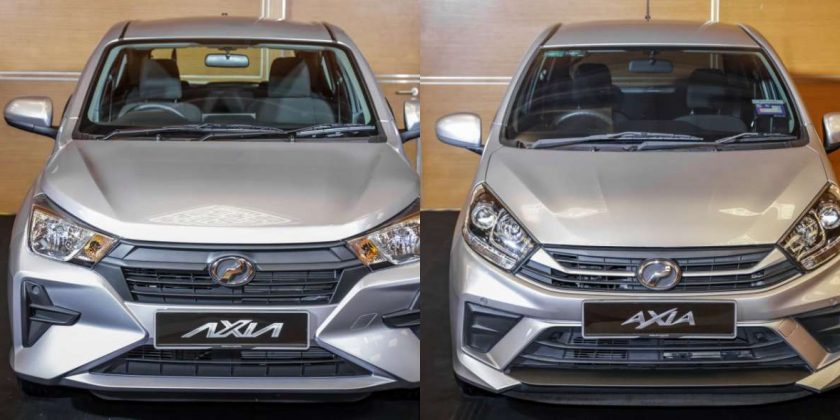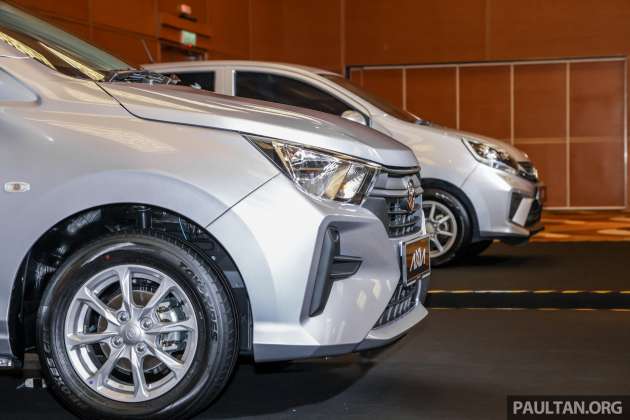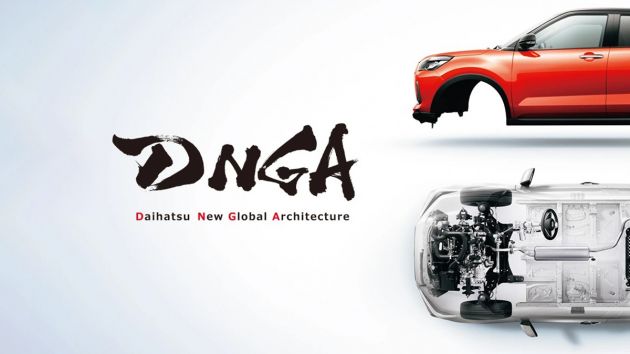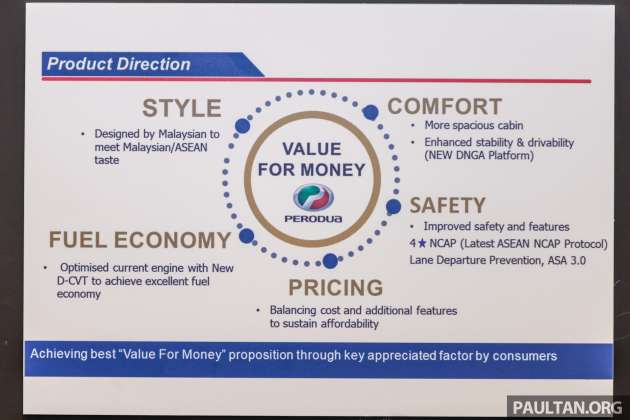The second-generation Perodua Axia has been launched in Malaysia to replace the first-generation model, which has been around since 2014 and received two facelifts during its lifetime, with the latest revealed in 2019. If you’re curious to know the specifications and pricing of the all-new D74A, head on over to our comprehensive launch report.
In this post, we’re comparing the two generations of the Axia and pointing out exactly what’s changed. We’ll be diving into various aspects, including the exterior and interior design, platform, powertrain, safety and price.
Daihatsu New Global Architecture (DNGA)
The new Axia is built on a completely new platform called the Daihatsu New Global Architecture (DNGA), which is also used by the Ativa, Alza as well as the fourth-generation Toyota Vios that made its debut in Thailand.
The modular architecture is akin to the Toyota New Global Architecture (TNGA) and succeeds the old Axia’s Daihatsu Global A-Segment Platform, promising improved driving dynamics and comfort, while also resulting in the new Axia’s larger body.
Bringing dimensions into the discussion, the D74A measures 3,760 mm long, 1,665 mm wide and 1,505 mm tall. By comparison, the old Axia is between 100 to 115 mm shorter in terms of overall length (depending on variant), while also losing in terms of width (-65 mm), but advantageous in height (+15 mm).
An important figure is the wheelbase, and the newer model’s spans 2,525 mm, making it 70 mm longer than the old Axia. In fact, the D74A’s wheelbase is 25 mm longer than the current Myvi that measures 2,500 mm.
Interior space and practicality
The more generous dimensions result in a few noticeable improvements on the inside. Firstly, the new Axia offers a better seating position than before, with the steering wheel and column placed at a more optimum angle, as are the pedals that no longer sees the driver’s legs being overly upright.
Rear passengers, particularly those of large sizes, will also enjoy the 40 mm wider couple distance so there’s less chance to bump shoulders. What’s unchanged is the distance between the front and rear passengers at 910 mm, which was already pretty good for kneeroom on the previous model.




The improved wheelbase also makes its easier for passengers to enter and exit the cabin, with the added benefit of boot space. Perodua says the distance between the rear seats and the tailgate is now 47 mm longer at 610 mm, which is enough to accommodate four suitcases, a stroller or even a bicycle.
Exterior design
The new Axia is clearly identified from the front by its more upright grille, which has a hexagonal-like shape and is flanked by more compact and angular headlamps. This is a radical departure from the large light clusters on the original, which trace their way further up the bodywork.
The D74A also has more prominent creases on its new and flatter clamshell bonnet, while the front bumper sports sharper lines that gives it a more aggressive “X-like” look than before. The older car, in facelifted form, had a larger lower intake and an “A-wing” like profile to its bumper.




In profile, the new Axia carries over its predecessor’s character line that cuts through the door handles, although it doesn’t rise as steeply and extends further to meet the tip of the taillights. This is accompanied by a flatter beltline that makes way for taller windows, improving the visibility out from the rear cabin space.
You’ll also notice the upswept crease on the newer car, which is a departure from the horizontal crease of the original, as well as the more rakish D-pillars that are accompanied by black garnishes to visually blend into the rear window.






Even from the back, the new Axia is instantly recognisable thanks to the new taillights that are more angular in shape to highlight the vehicle’s width. The largely featureless look of the previous car’s tailgate has also been addressed with two strong creases, with the upper one cutting across the Perodua logo and large hand insert for the boot opener.
Further down, the rear bumper has been slightly simplified as it no longer comes with decorative trim pieces at the corners. However, the number plate recess now has an upturned surround that is the opposite of the downturned look previously.
Interior design
The overhaul inside is equally as comprehensive as the exterior, with the V-shaped dashboard of old replaced with a more horizontal design and sharp lines. The new dash is also rather driver-focused given the infotainment head unit and centre air vents are slightly angled towards the driver.
Another area of improvement is the air-conditioning controls, which now take up less space compared to the large circular dials on the old Axia. The link between the centre stack and console is also more cohesive, allowing for a larger storage cubby just ahead of two cupholders and a more ergonomic gear lever that is now raised closer to the driver.


The handbrake sit further behind the raised centre console, surrounded by storage areas, including a square-shaped one that is brought higher to serve rear passengers. One thing that remains the same is the lack of split-folding rear seats, with the entire bench tipping down if you need more boot space.
Practicality and ergonomics aside, the new Axia does get more tech than its predecessor. Ascending up the variant tree, available features include a digital air-conditioning control panel with two memory settings, a PWR (Power) button on the steering wheel, a seven-inch digital instrument cluster and a nine-inch touchscreen head unit.
Powertrain
Under the bonnet, the new Axia carries over the same 1KR-VE 1.0 litre naturally-aspirated three-cylinder petrol, which continues to produce 67 hp and 91 Nm of torque. However, the engine is no longer paired with a four-speed automatic gearbox and is instead fitted with the same Dual Mode CVT (D-CVT) found in the Ativa, Myvi and Alza – read all about how it works here.


We’ve already tried out this new combo, and the results are impressive following our first drive of the new Axia which you should definitely read. With the D-CVT, fuel consumption is now 25.3 km/l, or up to 27.4 km/l with the Eco Idle auto start-stop system. Perodua says these figures are following the Malaysian Driving Cycle (MDC), which supposedly follows local road conditions and driving patterns.
Safety
The new Axia has already been awarded a four-star safety rating New Car Assessment Programme for Southeast Asian Countries (ASEAN NCAP), but keep in mind that the variant tested at the time was the SE that only had two airbags, Vehicle Stability Control (VSC), traction control and all-seat seatbelt reminder.
The higher-spec AV comes with six airbags as well as automatic high beam, lane departure warning/prevention, a blind spot monitor and rear cross traffic alert. These are on top of ASA 3.0, which includes autonomous emergency braking (AEB) and front departure warning, which alerts you when the front car has moved.
The previous Axia was also offered with AEB on its range-topping variant, but that was the older ASA 2.0 that didn’t include two-wheeled vehicle detection and a lesser operating range. Additionally, features like a blind spot monitor, lane departure warning/prevention and rear cross traffic alert were not available.
More importantly, lesser variants of the old Axia before the GXtra did not even come with VSC and traction control, so having it as standard for the new model across the board is a definite improvement.
Price
The Axia now starts at RM38,600 for the entry-level G, rising to RM40,000 for the X, to RM44,000 for the SE and at the very top of the range is the AV at RM49,500. The starting price is higher, but the features you get for the base option of the newer model is more fairly compared to the 2019 Axia facelift in GXtra guise that comes with VSC.
That GXtra variant was priced at RM34,990, while the AV of the previous generation went for RM43,190. Considering all the changes you’ve read through so far, is the upward pricing justified or do you feel otherwise? Share your thoughts with us in the comments below.
Source: Read Full Article



